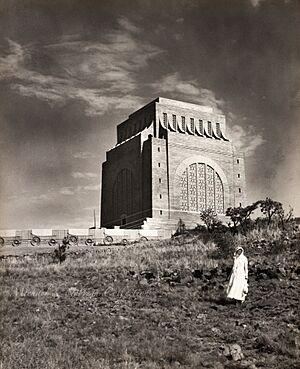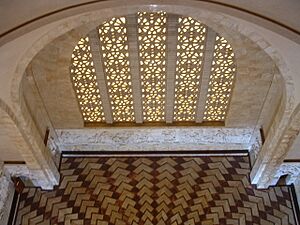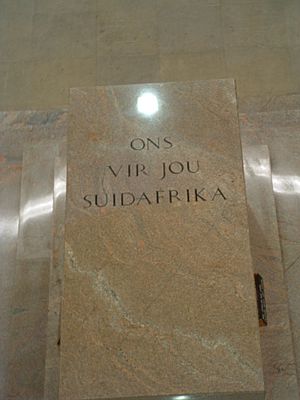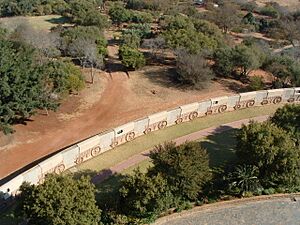Voortrekker Monument facts for kids
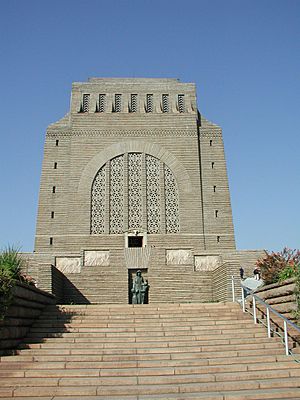
The Monument from the front
|
|
| Coordinates | 25°46′35″S 28°10′39″E / 25.77639°S 28.17750°E |
|---|---|
| Location | Pretoria, Gauteng, South Africa |
| Designer | Gerard Moerdijk |
| Material | Granite |
| Length | 40 metres (130 ft) |
| Width | 40 metres (130 ft) |
| Height | 40 metres (130 ft) |
| Beginning date | 13 July 1937 |
| Completion date | 12 December 1949 |
| Opening date | 16 December 1949 |
| Dedicated to | Voortrekkers |
The Voortrekker Monument is a large granite building located just south of Pretoria in South Africa. It stands on a hilltop and was built to remember the Voortrekkers. These were Dutch-speaking settlers who left the Cape Colony between 1835 and 1854. The monument was designed by an architect named Gerard Moerdijk.
On 8 July 2011, the Voortrekker Monument was officially named a National Heritage Site. This means it is an important place protected by the South African Heritage Resource Agency.
Contents
History of the Monument
The idea to build a monument for the Voortrekkers was first talked about on 16 December 1888. This was during the Day of the Vow celebrations in Natal. However, the actual plan to build it only began on 4 April 1931. A group called the Sentrale Volksmonumentekomitee (Central People's Monuments Committee) was formed to make it happen.
Construction of the monument started on 13 July 1937. A special ceremony, called a sod-turning, was performed by Ernest George Jansen, the head of the committee. The cornerstone was laid on 16 December 1938. Three women, who were descendants of important Voortrekker leaders like Andries Pretorius, Hendrik Potgieter, and Piet Retief, helped lay the stone.
The monument was officially opened on 16 December 1949 by the Prime Minister at the time, D. F. Malan. The building cost about £360,000, which was a lot of money back then. Most of this money came from the South African government.
A very large amphitheatre was built near the monument in 1949. It could hold around 20,000 people for events.
Main Parts of the Monument
The Voortrekker Monument is 62 metres tall. Its base is a square, 40 metres by 40 metres. The building looks a bit like some European monuments, but it also has African influences in its design. The two most important parts inside are the Historical Frieze and the Cenotaph.
The Historical Frieze
When you enter the monument, you walk into the Hall of Heroes. This huge room has a domed ceiling and four large windows made of yellow glass. Inside, there is a special marble Historical Frieze. This frieze is the biggest marble frieze in the world.
It has 27 carved panels that show the story of the Great Trek. They also show what daily life was like for the Voortrekkers, how they worked, and their religious beliefs. The panels illustrate important historical moments, from the first Voortrekkers in 1835 to the signing of the Sand River Convention in 1852. In the middle of the Hall of Heroes floor, there is a large round opening. Through this opening, you can see the Cenotaph in the hall below.
The Cenotaph
The Cenotaph is in the middle of the Cenotaph Hall. It is the main focus of the monument. You can see it from the Hall of Heroes above, and also from the very top of the building.
Every year on 16 December, at noon, a ray of sunlight shines through an opening in the dome. This light falls directly onto the centre of the Cenotaph. It lights up the words 'Ons vir Jou, Suid-Afrika', which means 'We for Thee, South Africa' in Afrikaans. These words are from the old South African anthem, 'Die Stem van Suid-Afrika'. The ray of light is a symbol of God's blessing on the Voortrekkers. The date, 16 December, is important because it was the day of the Battle of Blood River in 1838. This day was remembered in South Africa as the Day of the Vow before 1994.
The Cenotaph Hall is decorated with flags from the different Voortrekker Republics. It also has wall tapestries that show the Voortrekkers and display cases with items from the Great Trek. On the north wall, there is a special place with a lantern. A flame has been burning in this lantern since 1938. This was the year of the Symbolic Ox Wagon Trek, which started in Cape Town and ended at Monument Hill.
Other Interesting Features
Visitors enter the monument through a black wrought iron gate. It has a design that looks like an assegai (a type of spear).
After the gate, you enter a large circle made of 64 ox-wagons carved from granite. This number of wagons is important because the same number of wagons were used to form a defensive circle, called a laager, at the Battle of Blood River.
At the bottom of the monument, there is a bronze statue created by Anton van Wouw. It shows a Voortrekker woman and her two children. This statue honours the strength and bravery of the Voortrekker women. On the walls near this statue, black wildebeest are carved. These animals represent the dangers of Africa. Their symbolic flight suggests that the woman, representing Western civilisation, is successful.
On each outside corner of the monument, there is a large statue. These statues represent important Voortrekker leaders: Piet Retief, Andries Pretorius, Hendrik Potgieter, and an "unknown" leader. This "unknown" leader represents all the other Voortrekker leaders. Each of these statues weighs about 6 tons.
At the eastern corner of the monument, on the same level as the entrance, is the foundation stone. Inside this foundation stone, several important items are buried:
- A copy of the Vow made by the Trekkers on 16 December 1838.
- A copy of the anthem "Die Stem".
- A copy of the land agreement between the Trekkers, led by Piet Retief, and the Zulus, led by King Dingane.
The Sun Ray and its Meaning
The architect, Gerard Moerdijk, designed the monument to have a special meaning. He believed that the purpose of a building should be clear. Inside the monument, looking down from the top dome, you can see a pattern on the floor of the Hall of Heroes. It looks like 32 sun rays spreading outwards. The natural sun, shining through the floor opening, forms the 33rd ray.
Moerdijk said the pattern on the floor represents water, like in ancient Egypt. He believed that all building art goes back to ancient Egypt. The round opening in the floor can be seen as a symbolic "watery abyss." From this "abyss," the Cenotaph rises, like a new creation.
The monument's large upper dome is designed to look like the sky. Through this dome, a sun ray shines down, highlighting words on 16 December at noon. The words highlighted are: "WE FOR THEE, SOUTH AFRICA." These words are from the anthem "Die Stem," which also says: "It will be well, God reigns."
This sun ray creates a connection between the words on the Cenotaph and the sky above. It symbolises a communication between God and people. The sun ray itself forms a 33rd ray of light shining onto the stone in the middle of the floor opening.
The Trekkers believed that God was on their side in South Africa. This belief came from a vow made by Trekker leader Andries Pretorius at Blood River between 9 and 16 December 1838.
Monument Complex and Surroundings
Over the years, the area around the monument has grown. It now includes several other features:
- An indigenous garden that surrounds the monument.
- Fort Schanskop, a nearby fort built in 1897. It is now a museum and became part of the monument complex in 2000.
- The Schanskop open-air amphitheatre, which opened in 2001 and can seat 357 people.
- A garden of remembrance.
- A nature reserve, created in 1992, covering 3.41 square kilometres around the monument. You can find animals like Zebras, Blesbok, Mountain Reedbuck, Springbok, Black Wildebeest, and Impala here.
- A Wall of Remembrance, built in 2009. It honours members of the South African Defence Force (SADF) who died serving their country between 1961 and 1994.
- A memorial, opened in 2012, to remember the victims of the attacks on Air Rhodesia Flight 825 and Flight 827, known as the Viscount Disasters.
- An Afrikaner heritage centre, built to help preserve the history and contributions of Afrikaans-speaking people in South Africa.
Images for kids
See also
 In Spanish: Monumento al voortrekker para niños
In Spanish: Monumento al voortrekker para niños
- Great Trek
- Völkerschlachtdenkmal



